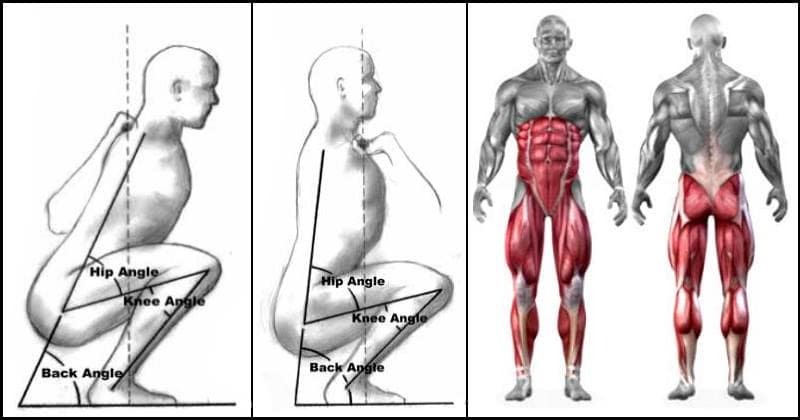
by admin | Jun 7, 2022 | Health, Fitness
When Should You Go To The Gym?
You want to be a badass, right? You want to be the guy or girl at the gym who is always killing it, setting personal bests, and looking good while doing it. The thing is, there’s more to being a badass than just hitting the gym hard.
In order for your hard work in the gym to pay off, you need to make sure you’re hitting it at the right time. So when should you train? Well, there’s a lot of debate over when the best time to work out is. Some say mornings, others say evenings.
But of course, much like anything else, there are a variety of factors to consider, so let’s have a look!
Circadian Rhythms
Your circadian rhythms are the physical, mental, and behavioral changes that follow a roughly 24-hour cycle. They’re regulated by the hypothalamus, which is part of your brain. The hypothalamus responds to light and dark signals it receives from your eyes.
These signals help to set your body’s natural clock or circadian rhythm. Now, considering the fact that this natural rhythm of the body controls the biochemistry, as well as the activity of the central nervous system, it’s easy to conclude that at one point of the cycle, we’d have performance.
In this review, it is suggested that muscle strength exhibits a circadian pattern. The research demonstrates that maximum isometric strength varies during the day and peaks in the late afternoon (4 to 8 pm). So here’s for a first checkpoint – Circadian rhythm-wise, it’d be best to do your strength workouts in the late afternoon.
Muscle Glycogen

Alright, so the first thing to consider is the phase of your natural cycle, which you are at during the workout (just what we discussed above.) But that’s just one part of the story! The second important consideration is – Do you have fuel to get the best workout possible? The primary source of fuel for heavy workouts in the gym is the so-called ‘muscle glycogen.’
Essentially, muscle glycogen is the stored version of carbohydrates (the body stores whatever it doesn’t use.) If your muscle glycogen is depleted, you are likely to have a suboptimal workout. And well, unfortunately, muscle glycogen and blood sugar are at their lowest in the morning. So if you’re planning to start doing your strength workouts in the morning, think again!
Because that might hinder your performance. Have a meal or two with quality carb sources in the hours leading up to your workout!
Recovery Time

The third and perhaps most important consideration is this – Are you recovered from your previous workout? As you may or may not know, during weighted workouts, we inflict micro-damage to the muscles and also ramp up the nervous system. All components engaged in strenuous exercise need time to recover before they can get their peak output and capacity back (with some more of it added, which we call ‘gains’)
With this in mind, you’d want to optimize the recovery times between each workout in order to perform at your best every time. Generally speaking, you’d need 48 to 96 hours between each training session for each muscle group.
What this means is that if you train your pushing muscle groups on Monday at 4 pm, you’d be best off doing this workout again later on in the week, on Thursday or Friday.
The Verdict
So, when is the best time to go to the gym? The answer isn’t always clear-cut, but hopefully, this article has given you a few things to think about. If you want to get in shape and don’t mind sweating it out during prime-time TV hours, then evening workouts might be right for you. But if you prefer peace and an earlier bedtime, mornings may be better.
Ultimately, it all comes down to what works best for your schedule and fitness goals. Just make sure you stick with it – consistency is key! Are there any other times of day that work well for you? Let us know in the comments below.

by admin | Jun 7, 2022 | Fitness
Why Fat Loss Is Easier Than Gaining Muscle
If there’s one thing that almost everyone in the gym can agree on, it’s that losing weight is a heck of a lot easier than gaining muscle. And while there are certainly exceptions to this rule, for the most part, it’s true.
So if you’re looking to drop a few pounds before summer hits, read on – you’re in luck! In this post, we’ll take a look at some of the reasons why fat loss is typically easier than muscle gain and offer up a few tips to help you get started.
Ready to learn? Let’s go!
Why Do We Gain Fat

To start, let’s do a brief analysis of both processes to understand what they require.
First and foremost, it would be essential to understand the primary function of subcutaneous body fat (the fat that makes us look fluffy.)
That is, its energy-storage function!
You heard it right – Excess body fat is nothing but your body saying, “Hey, you consumed some more energy than I need to maintain, so I’ll store it for later use!” In essence, even though we don’t like how excess fat makes us look, it is there because the body is smart and doesn’t let any unused energy go to waste.
With that in mind, we can say that when getting rid of the excess body fat, it is best to view it as something you use, rather than something you lose!
Why Do We Gain Muscle

Contrary to gaining fat, which mainly serves as energy storage, we have a different type of gain – That of active muscle mass! Unlike fat, the function of muscle mass is to help you sustain performance through a variety of loads. Generally speaking, the type of muscle mass gained depends on the stimulus created.
If you’re mainly training in the strength range of 1-5 reps with heavy weights, you will induce what’s known as “myofibrillar hypertrophy.” This fancy scientific term refers to the growth of the contractile muscle units, called ‘myofibrils’ (otherwise known as ‘muscle fibers’)
On the flip side, if you’re mainly training in the bodybuilding range of 6-15 repetitions with heavy weights, you will induce some myofibrillar hypertrophy and some ‘sarcoplasmic hypertrophy.’
The latter is referred to as the growth of the ‘sarcoplasm,’ which is a jelly-like fluid that contains energy substances used during prolonged high-intensity activity. In simple words, such training results in greater strength endurance.
But Why Is Gaining Muscle Harder?

The answer to this question is quite simple – Gaining muscle basically implies adding active mass that has more complex functions than fat!
This means that all the stimuli and internal processes that lead to the gain of active muscle mass are much more complex and more challenging to nail than those that lead to fat loss. Because with fat loss, you have a couple of basic principles to follow that will get you most of the results.
Those are namely:
- Eating in a caloric deficit
- Consuming enough protein/fats and some carbs
- Sleep well/manage stress
Contrary, in a muscle-gaining phase, you have to:
- Consume food in a caloric surplus
- Progressively overload
- Nail rest-times between sets
- Nail rest-times between workouts
- Sleep well/manage stress
Now, of course, that is not to say either process is a walk in the park when you start doing it. However, gaining and maintaining quality muscle mass is a much longer process, which leads us to believe that generally speaking, fat loss is a tad bit easier!
That is, of course, if you find a sustainable approach you can stick to (which should be your primary goal when building up your fat loss regimen.)
Final Thoughts
If you want to lose weight, it may be easier than you think. But if your goal is to gain muscle mass and increase strength? It’s a whole different ball game.
The key difference between fat loss and gaining muscle is that the latter requires commitment and consistency for MUCH longer periods of time – something most people don’t have!
Which body transformation goals are you working on at the moment? Let us know in the comments!

by admin | Jun 5, 2022 | Fitness, Workouts
Legs & Abs Exercises You Aren’t Doing That You Should Do
If you are like most people, you probably think you are doing all the exercises that you should be. However, there are probably a few exercises that you are neglecting that can provide some major benefits. In this blog post, we will outline four exercises that you may not be doing, but should definitely add to your routine. Keep reading to learn more!
#1 Front Squats

Many people do back squats, where the barbell is placed on the top of the traps, but not that many people do front squats. Front squats are one of the most effective lower-body exercises because they place a slightly different emphasis as opposed to back squats. This is because the barbell is placed on your shoulders, rather than on your back. Additionally, front squats can help you keep your spine safe and bring up your glutes if they are lacking.
#2 Romanian Deadlifts
Romanian deadlifts are one of the best exercises for the hamstrings and glutes. This type of deadlift is a compound exercise that involves both the lower and upper body, making it an extremely effective way to train the entire body. But really, as we just said, where this exercise shines, is its ability to target the glutes and hamstrings! Usually, deadlifts are done on the days when you train back, but with this variation, you can include it on your lower body training days!
#3 Hanging Leg Raises
Hanging leg raises are one of the most effective exercises for the abs. This is because they work the entire abdominal area, including the lower abs, which are often difficult to target. To do a leg raise, you can in fact start with a knee raise! Hang on a pull-up bar and lift your knees up to your chest, contracting the abs.
Once you get used to this movement and controlling the swinging of your body, move on to a leg raise, where you flex your ankle, keep the legs straight at the knee and bring them up. Here’s a cue: Try touching the ceiling with your toes!
#4 Stomach Vacuums

Speaking of effective ab movements, we can’t skip the stomach vacuums! The stomach vacuum exercise is a bodybuilding move that originates from the golden era of the sport. It was first made popular by bodybuilder and fitness icon Frank Zane, and has been used by top-level athletes and bodybuilders for decades. The exercise is simple but extremely effective, and can help you achieve a tight, toned midsection. And doing it is quite simple:
- Put your hands on your knees
- Exhale fully, while flexing your abs
- Keep the abs flexed
- Tuck your abdominal wall under your ribcage
- Hold briefly!
Conclusion
If you’re looking to change up your leg and abdominal routine, give some of these exercises a try.You may find that you enjoy them more than the standard exercises you usually do, and they could help you achieve better results. And if you don’t like any of these suggestions, there are plenty of other exercises out there that can help strengthen your legs and abs. Stay tuned on our website!

by admin | Jun 5, 2022 | Fitness, Mind
Training & Nutrition as tools | Realizing Your True Physical & Mental Potential
We live in times where fitness has become a massive trend and paradoxically, fewer people consider it important, giving way to other things to get on top of their priority list. The collective paradigm about health, nutrition, and fitness has been warped beyond belief. This therefore leads to more people than ever getting lost in a vicious cycle of non-sustainable physical, nutritional and mental habits.
And while getting fit and starting a diet is just a “Someday” goal for many people, the truth is that it is the natural way the body should work.
The Modern-Day Lifestyle

Humans as a species have been on this planet for at least 200,000 years and for the most part, it has been a survival game. It has only been the last 30 years that we’ve had easy access to such an abundance of foods, which can even be delivered to your doorstep! So, you see where this is going, right?
We are way beyond our natural human patterns of movement and nutrition, working sedentary jobs and eating heavily-processed, nutrient-poor foods. What we now call training is actually the way things worked for most of human existence.
Here’s The Best Part Though
Your HEALTH determines your performance in every other aspect of your life. Think about it, too many people often get to the point where neglecting their body becomes habitual, rather than a choice. This usually leads to an overall decrease in the quality of life, where they feel mentally and physically exhausted just a couple of hours into the day. As this happens, it gets harder to focus and perform well on your other activities.
This is where physical, nutritional, and mental practices come into play.
Fitness & Nutrition as tools

By now you should know that the best thing you can do to improve your performance in every aspect of life, is to keep your body & mind healthy. And quite frankly, the physical part of it is really simple – Using your body’s active components (training) and granting fuel for performance & recovery (food). As we mentioned above, the modern-day lifestyle imposes us to an environment where EVERYTHING we need is right around the block.
The question is, are you going to go to the gym or the pub?
Are you going to go to the grocery store or the burger joint?
Making all the right choices that will nurture all the various functions of the body, will ultimately set you up for a clear vision and good performance in all aspects of life. The goal is to create a plan you can adhere to and bring into your older years, to live a healthy and fulfilling life.
Physical & Mental Practices Anyone Can Use
Now that we have a firm grasp of the fact that taking care of your body is the least and easiest thing you can and should do, let’s have a look at actionable steps you can take towards that.
1. Bring diversity in your nutrition
Nowadays, more often than not, there are fad diets that overwhelm people trying to set up a concrete nutrition plan. Should you do keto, paleo, low-carb or intermittent fasting? The short answer is – Use whatever you can stick to in the long term. But when building out your nutrition plan, consider this: A balanced approach to nutrition is the best way to go, as each and every macro and micro nutrient has its own purpose in your physiology.
Eat some meat, some fish, grains, dairy products, fruits, vegetables, nuts and any other whole foods you may have in the local store. Remember that the different colors of food simply show the different nutrients available in that food. In this case, the more colorful your plate is, the better.
Enjoy food not only as a functional component of your health & recovery plan, but also a form of enjoyment and art.
2. Include endurance, strength & functional training

Your body is a complex biological machine that has a musculoskeletal system, used to move in the environment in a variety of ways. As we mentioned in the beginning of this article, the modern-day lifestyle robs us of most movements which we would otherwise do. This is exactly why, it is best to use as many functions of your body as possible. Contrary to popular belief, your “fitness” is not just about going to the gym and lifting weights.
It is much more than that. Your body can run, swim, climb, crawl, jump, pull, push, etcetera… Think about it – Each of those movements engages a different set of active components (muscles) The more of those components you frequently engage in challenging training sessions, the better your overall development will be. This is mostly valid for people who are not athletes, as competitive sports would require a different approach, the goal of which would be to maximize on a couple of physical properties.
3. Take care of your recovery
Whether you are doing light cardio or grueling strength training, leaving a window for recovery before the next session is always mandatory. It is this exact recovery window that allows the trained muscles/functions to reach the state of supercompensation. Supercompensation is essentially the point during recovery, at which the exercised muscles/functions have a higher working capacity than they did prior to the training bout.
This is what progress actually is – Your body preparing for bigger challenges! Here are our best tips to optimize your recovery:
- Get 0.8-1g of protein per lb. of bodyweight
- Eat 0.45g of fat per lb. of bodyweight
- Consume a solid amount of carbohydrates
- Hydrate yourself well (Avoid excessive thirst)
- Sleep 6-8 hours a night
- Let each muscle group rest at least ~72 hrs between strength training sessions
- Rest at least 24 hours between prolonged aerobic (cardio) sessions
- Get frequent deep tissue massages
4. Breathe more!
Besides robbing us of movement, the modern-day lifestyle often instills passive stress into the mind. If your mind is stressed, so is the body and we all know that chronic stress has long-term side effects that manifest in many aspects of our lives. And quite frankly – You don’t want that. This is where breathing exercises come into play.
Now, breathing is normally an autonomous function… until the moment you think of it. And this is actually good!
Consciously controlling your breathing pattern can have massive benefits on your autonomous nervous system (ANS) right away. Just 5-10 deep, slow inhales and exhales can instantly act as a powerful signal for the body.
That exact signal tells the ANS that it is time to relax and recover, thus allowing many glands in the body to secrete health-nurturing substances. The step-by-step breathing practice we have for you below, can be used daily to manage any type of stress and bring harmony back to the heart & brain.
Breathing practice
- Sit down comfortably and close your eyes, preferably on a quiet spot
- Place your hand on your chest and shift your attention to your heart
- Inhale slowly through your nose and into the belly, then up to the chest
- Exhale slowly through your nose, releasing any bodily/mental tension
- Repeat and focus your attention to your heart and breathing
This is essentially a meditation practice which has powerful effects even when done for a couple of minutes per day. The main goal is to focus on your heart & lungs and induce a powerful self-regulation signal. If any intrusive thoughts come to your mind, don’t follow and multiply them, just let them go and return your attention to the heart and lungs.
To Wrap It Up
Doing regular physical/training activity, eating well and practising mindfulness shouldn’t really be considered “goals”. These are rather just the tools you can and should use to set yourself up for better performance in any other aspect of your life. Modern-day cities provide everything you need for a complete biological optimization, right at your fingertips. But the catch is that they also make it easy for you to create a full-on biological disaster. The question is, which route are you gonna go? Choice is yours, make the rest of your life the best of your life.

by admin | Jun 5, 2022 | Health, Fitness
Shoulder Injuries & The Rotator Cuff | Part 2 – Preventing Shoulder Injuries
In the first article of this series, we gave you a basic overview of the shoulder anatomy and made a couple of things clear:
- The shoulder is a mobile, but vulnerable joint
- It is comprised of superficial muscles (deltoids) but also deep, stabilizing muscles (the rotator cuff)
- The shoulders are involved in all upper body movements in some way, further increasing the probability of injury
We also had a look at some common shoulder injuries, such as rotator cuff tears, dislocations, bursitis, and shoulder socket inflammations (frozen shoulder). In this second article, we are going to tell you more about how you can prevent these unpleasant injuries and enjoy sustainable upper body training for years.
Without further ado, let’s get to it!
How To Prevent Shoulder Injuries

In most cases when people think of shoulder training, the first things that come to mind are weighted exercises like dumbbell presses and front raises. And while those are certainly good picks for developing strong deltoids, they give the rotator cuff very little work to do. As you lift heavier and heavier on those movements, the cuff is imposed to progressively greater amounts of stress, making it far more likely for an injury to occur.
Below are our best tips that you can use to minimize the risk of a shoulder injury.
Tip #1 Train your rotator cuff!

As we just said, the traditional shoulder exercises do not really emphasize the rotator cuff, which is a detrimental element of shoulder health. Implementing resistance band rotator cuff exercises in your routine is a perfect way to exercise all shoulder functions and keep the joint healthy.
Furthermore, this type of exercise is a good way to warm up the shoulders and prime them for the heavier lifts in your workout. Here are the 4 best resistance band exercises for your cuff, with written exercise steps:
1. External rotation
Attach the resistance band securely on a pole/anchor at the height of your belly button. Stand next to the band and hold it with your outside hand, with an overhand grip. Maintain an upright torso position, keep the back straight and avoid hunching your shoulders. Pull the band, opening the arm to the outside (external rotation) – Do this slowly to maintain tension. Go back to the initial position slowly, keeping the tension on the shoulder.
This exercise can also be done on both arms simultaneously, by holding a band closely with both hands and stretching it out with the same external rotation. NOTE: Keep the upper arm closer to the body!
2. Internal rotation
With the same initial position, hold the resistance band but this time with your inside hand. Step away from the resistance band so that it starts generating tension. Close the arm in, pulling the band towards your belly button. Again, use an even pace that is relatively slow, on both portions of the movement.
NOTE: Don’t let the band lose tension
3. 90-Degree External rotation

Attach the band to a pole/anchor at lower chest height and stand in front of it. Move to the side, so that the band is right in front of your working arm. With that same arm, grab the band and take a step back to generate tension. Raise your arm up so that the upper arm is parallel to the ground, with elbow bent at 90-degrees. Pull the resistance band back, raising the arm to a 90-degree vertical angle. Go back down slowly, maintaining the tension on both portions of the movement.
NOTE: Do this movement on both sides!
4. Downward Pull (extension)
Attach the resistance band to a higher spot, so that it is anchored above you. Stand in front of the band upright then grab it with a neutral grip (palm facing to the opposite side). Take a step back to generate resistance, keeping the arm straight and parallel to the ground. Pull the band down to the side of your hip slowly, then return to the initial position.
NOTE: Again, do the movement slowly on both sides – Even pace.
Tip #2 – Manage Your Workout Split
As we mentioned, the shoulders are engaged in all upper body movements. This is exactly why your training split should allow them to recover properly, before having them engaged heavily again. To do so, you can:
- Avoid direct shoulder training the day before chest training
- Place a lower body or rest day in-between upper body training sessions
- Combine all pushing muscle groups in 1 workout with lesser volume
By carefully distributing your heavy pushing movements across your workout plan, you will allow all tendons and muscles to recover and perform optimally, thus reducing the risk of injury.
Tip #3 – Manage Your Workout Intensity
If you go all-out on every single upper body workout, odds are that sooner or later a shoulder injury will occur. This is exactly why managing your workout intensity (working weight) is of prime importance for shoulder health (and joint health in general). Higher intensity by nature is more demanding and thus, requires more time to recover from.
To manage your intensity, you can:
- Leave a couple of reps in the tank – Don’t go to failure on every set
- Program higher intensity days & moderate-intensity days
- Every now and then, use lower weights for more reps
In doing so, you will allow all shoulder muscles to become stronger from workout to workout.
Tip #4 – Use Compound Movements
The more you isolate a muscle group, the bigger the chance of tendon inflammation and/or tear is. This is exactly why, compound movements that utilize a variety of muscle groups, are a viable injury prevention tool. These exercises will allow secondary muscle groups to engage in the movement, thus supporting the shoulder and its muscles.
In doing so, you will not only take away from potentially harmful tension of the shoulder joint but will also be able to lift heavier to maximize shoulder development.
Here are our best compound movement picks:
- Standing barbell overhead press (uses the shoulders & triceps, back muscles stabilize the torso)
- One-Arm dumbbell overhead press (uses the shoulders & triceps, engages the rotator cuff more to balance the arm)
- One-arm dumbbell lateral raises (uses the shoulders & trapezius, reduces peak contraction angle leading to less pressure on the joint)
Tip #5 – Warm up, warm up, warm up!
Last but not least, warming up before heavier lifts is of prime importance for shoulder health. A good warm up will kick up your heart rate, warm your body up and activate the muscles you’re going to target in your workout. Generally, if you combine low-intensity cardio (5-10 minutes) with the resistance band exercises you are good to go. Additionally, it is recommended that you gradually increase the working weight on your first couple of sets, in order to work your way up to higher intensity.
To Wrap It Up
The shoulder is a complex, very mobile joint that generally lacks stability, making it vulnerable during high exertion. For this reason, key elements of your workout plan are important to consider, in order to prevent an injury. Those are your warm-up, exercise choice, recovery periods between upper body training sessions, as well as proper integration of auxiliary, strengthening exercises for the rotator cuff. By making sure you have all these key points in check, you make it far less likely for a shoulder injury to occur.

by admin | Jun 4, 2022 | Fitness
How To Create A Fitness Plan
Keeping fit is very crucial to your health. By working out and engaging in physical activities you reduce your susceptibility to chronic illnesses such as heart attack and obesity. However, you need to have a reliable plan to ensure you achieve your fitness goals. To create a fitness plan that is very efficient and effective, you will need to do the following;
Define Your Fitness Goals

As you embark on a fitness journey, you need to have set out goals you want to achieve. Do you want to gain muscle? Or do you want to lose weight? By defining your goals and learning by heart the ultimate results of working out, you stay committed to your fitness journey.
Have A Routine
A great fitness plan should spell out the time to engage in a workout or a particular physical activity. You cannot exercise the whole day. There has to be a reasonable schedule for both light and intensive training fitness exercises. Schedule all your fitness activities and follow that routine religiously to keep you motivated in your quest to stay fit.
Begin Slowly and Build On As Time Goes By
As a beginner, you do not go lifting heavy weights with immediate effect. You must start slowly. In case you have a critical medical condition or injury, consult your doctor to help you in the process of creating your business plan. You can then start building on your physical activities as time goes by alternating among several activities such as strength training, swimming, walking, and biking. Also, include high-intensity training and activities to be undertaken within specified intervals.
Time To Recover

The fitness plan should also create room to relax and recover. You just cannot spend the entire day training. There are possibilities you might get injured or get bored with the entire exercise. In fact, some people who start training in high spirits end up quitting along the way due to sore joints and muscles. This is why it is very important to have those breaks to allow your body to heal.
Monitor Your Progress

As you follow your fitness plan, you must also monitor your progress. You need to know if the plan you put in place is viable or a waste of time. This is why you constantly have to measure your pulse rate, body mass, determine the number of push-ups you can rack up and your waist circumference. In doing so, you monitor your body composition, flexibility, muscular and aerobic fitness to determine if the changes are in line with your fitness objectives or not.
Conclusion
A fitness plan acts as a guide to help you stay fit and healthy. You need to know when to workout, the kind of workouts suitable to you when to rest, and make any changes to your plan. Therefore, every fitness enthusiast should get to easily define their goals, create a routine for training and list the physical activities to engage in, rest, and monitor their fitness progress. Those are important factors that influence any fitness plan.
Page 3 of 14«12345...10...»Last »


























